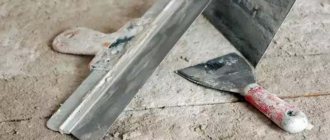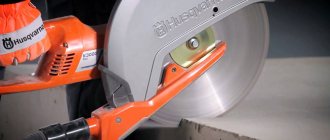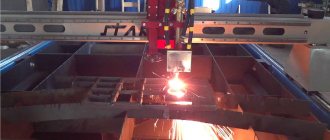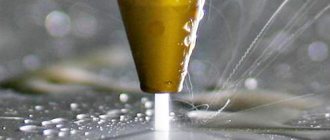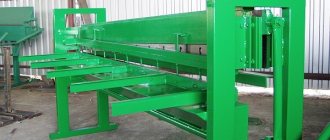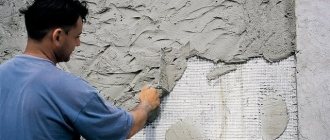When performing various types of household work, the need to cut metal often arises. This process itself does not cause difficulties. But to perform it you need to have a specialized tool. The simplest is the usual “grandfather’s” hacksaw for metal. She will cope with the task, but the investment of time and effort can unpleasantly surprise a modern person. Fortunately, many other tools for mechanical cutting of metal are now available.
Metal scissors
Metal scissors are also effective for cutting. Depending on the type and thickness of the material, the following types of tools are distinguished:
- ordinary hand scissors (used for sheet steel with a thickness of 0.4 - 1.1 mm);
- chair scissors (they have large dimensions and are suitable for steel up to 2.5 mm);
- power shears (for steel up to 5.0 mm);
- lever or swing shears (for long material with a thickness of up to 3.0 mm);
- guillotine (have inclined knives, suitable for thick steels up to 32 mm).
Metric thread
In the mechanical engineering industry, this type of thread is most often used. It got its name – “metric” – because its technical characteristics are measured in millimeters. The thread profile is made in the form of a triangle. The angles at its vertices are 60°.
Peculiarities
Metric threads are manufactured with both fine and wide/coarse pitch. In the figure below, this parameter is indicated by the letter “P”. Let us note the main features of the use of threaded steps of both types.
- Small is used in diameters varying in the range 1.0 mm ≤d≤ 600.0 mm, and large is used in diameters 1.0 mm ≤d≤ 68.0 mm.
- Fine cutting is important for forming connections with increased tightness.
- Large threads are suitable for connections subject to impact loads.
- Most adjustment connections are made using finely rolled threads. The reason is that the small distance separating adjacent turns facilitates the procedure for modifying parameters
Let's name the main ones.
- The ridges of inch joints are characterized by greater length, but they are less wide. The shape of metric thread turns is more balanced - their length is shorter and they are wider.
- The difference in profile does not allow the connection of parts on the surface of which inch and metric threads are rolled. The fastening will be fragile and, no less critically, leaky. This may cause liquids to leak during transport.
Electric metal shears
An excellent metal cutting effect is achieved using electric scissors. There are more than 10 varieties of this tool, but they are united by the ability to cope with almost any material, as well as the ability to carry out shape cutting. Electric metal shears can be considered a specialized tool for these purposes.
Thus, there are a lot of devices that can cope with the task in question. Which device to choose depends on the frequency with which you have to cut metal, the thickness of the material and your budget.
Breaking down the basics
The main element through which metal carving is made is the gravel. But there are a huge number of varieties of this tool that make it easier to work with different types of carving. For example, with a messer-sticker you can make very, very thin lines, and with a rep-sticker you can make parallel patterns.
Craftsmen advise purchasing a set of tools in specialized stores, because this will make your work easier.
A couple more tips from experienced professionals on how to do the work at home: the work should be done on your own, and the tool should be held like a regular ballpoint pen.
Read this: Bird wood carving: photos of interesting ideas for creativity
There is a simple method that most craftsmen started with; it tells you how to make a good product.
For carving, we use a metal object on which we want to make (for a gift, to practice) a text or a drawing. Next, you take a disposable glass into which you pour water and dissolve a lot of table salt in it. You also need electrical tape, which should be wrapped around the entire metal part, leaving only the tip.
Using a sharp knife, cut out the text/drawing on the electrical tape. Then, taking a DC generator, attach the positive end of the wire to our object, and the negative end to a nail or metal plate. We immerse all metal parts in a saline solution and turn on the generator to the electrical network. After a short period of time you will notice the engraving. This is one of the easiest ways to carve metal.
Of course, you shouldn’t cut out everything at once, because on the Internet and in various literature there are many patterns that inspire with their beauty. You can find thousands of different designs, like the one by Canadian artist Cal Lane. At first, this woman was simply fascinated by ornaments, looked for them in thematic magazines or the Internet, and then she learned to cut out such unusual design patterns herself. All designs and openwork lace came into carving from various types of art (they covered tablecloths or decorated houses). Most often these were stretching and intertwining plants, huge leaves, and less often flowers.
Read this: Wood carving: a selection of creative ideas
For any thread, the following main elements are distinguished: thread profile, profile angle, profile height, thread pitch, outer diameter, middle and inner diameters of the thread. Very often the smallest elements are depicted; large ones do not look very aesthetically pleasing. Also in the patterns you see birds, animals, and some make copies of people, which are decorated very beautifully. You are provided with a selection of various photos about patterns and elements for them. In the 4th picture you will see the same Cal Lane, and then her work. Her creations are most often made from unnecessary things that people wanted to throw away.
There are a lot of different types of metal engraving on the Internet, which you can choose to suit your taste and color. This article will talk about only some of the more famous ones.
Diamond engraving is used when working with various expensive metals (gold, silver). A huge advantage of this carving is that the metal is not removed, but only bends under the influence of the engraver’s force.
Read this: Photo of carving of vegetables and fruits: figured cutting of paintings and bouquets
Photo engraving. A fairly common occurrence and, by the way, a great gift. The photograph is divided into small squares, which are subsequently transferred to the metal. The depth of the product itself will depend on the strength.
Milling is a fairly common form of engraving due to frequent use. It uses milling cutters or conical engravers, which rotate very, very quickly. Interestingly, jewelry making is done using a combination of the first and third methods. These products are very different in complexity and sophistication of details, everything depends on the hand of the master and his experience.
Unfortunately, elements made using solvents wear out very quickly, but there are more effective technologies that will extend the life of your product (laser engraving or mechanical). Laser engraving is a very good method and can be used to cut very fine and fine lines. But the only drawback is that this is a very expensive activity; for a small laser you need to pay more than 15,000 rubles.
Mechanical engraving is much cheaper, but you must have a lot of experience, because this is very painstaking work and not everyone knows how to cut out various details so clearly. This work will require a “sharp eye” and a trained hand.
Conical pipe thread
The profile of a conical pipe thread is the same as in the previous version, but the difference lies in the decrease in diameter as you move from the beginning of the thread to the end of the pipe element. The above GOST clearly states that threads of this type are used when it is necessary to ensure the tightness of a pipeline operating under high pressure.
Peculiarities
One of the key features is the requirement for the angle of deviation of the pipe axis from the framing surface of the cone.
Regardless of the diameter, it should form a slope in the proportion of 1:16. This means that the angle φ (see figure) should be 1 degree, 47 minutes and 24 seconds. Other features of conical pipe threads include:
- the number of turns per inch depends on the diameter of the product. In particular, on a segment of 25.4 mm, a minimum of 11 turns can be rolled, and a maximum of 28;
- thread pitch is within 0.907 mm ≤Р≤ 2.309 mm;
- length of the common threaded section on the surfaces of the mating elements after screwing one into the other (parameter l2 in the figure): with a minimum thread of 1/16″ - 4.0 mm; when the thread diameter is maximum 6″ – 28.6 mm.
Functional aspect and purpose of threaded connections
A screw thread is defined as a ridge of uniform helical cross-section on the outer or inner portions of a cylinder. The latter refers to nuts, and the former refers to bolts, studs or screws. In our online store “First Fasteners” you can buy stud bolts and screws with delivery to any region of Russia. The nut wholesale will have a price from the manufacturer.
The thread form is the configuration in the axial plane or it is a profile consisting of a flange, root and flanks. There are ridges at the top of the threads, roots at the bottom, and the sides connect them. The triangle formed when the thread profile expands to a point at both the ridges and roots is the fundamental triangle. The height of the basic triangle is the radially measured distance between the ridge and the diameter of the root.
The distance measured parallel to the thread axis between corresponding points on adjacent threads is considered the thread pitch. Standardized screw threads are designated by the number of threads per inch of length. This is the number of complete cuts found in one inch. The metric cutting pitch is the distance from two adjacent turns in millimeters.
On an internal cut, the small diameter goes to the ridges, and the large diameter goes to the roots. If the thread is external, then the large diameter is located at the crests of the thread, and the small diameter is at the roots.
Flank (flank) angle is the angle between the flange and the perpendicular axis of the thread. Flank angles are sometimes called "half-angles" of a thread, but this is only true when adjacent flanks have the same angles, that is, the threads are symmetrical. The unified screw threads have a flange angle of 30° and are symmetrical. This is why they are commonly called 60 degree threads.
The pitch diameter is the diameter of the theoretical cylinder that passes through the thread such that the distance between the thread flanges and the roots is equal. When making a bolt and nut, a gap is intentionally created between the mating threads. This allowance is known as allowance.
The presence of an allowance ensures that when making threads there will be positive space between them. For fasteners, it is usually applied to external threads. Tolerances are certain amounts by which dimensions can be varied for ease of manufacture. This is actually the difference between the maximum and minimum legal limit.
This method of fastening individual parts has gained popularity because it has many advantages:
- high strength and long service life;
- the ability to create prefabricated/collapsible structures;
- simplicity and availability of tools for installation/disassembly;
- adjusting the tightening force;
- low weight and dimensions of the fastening element in relation to the mounted parts;
- a wide variety of types of connecting components.
Threaded connections are used for various purposes:
- ensuring tightness under internal or external fluid pressure;
- creating sufficient structural rigidity when transmitting external applied loads;
- forming good geometry so as not to increase the outer diameter or significantly reduce the inner diameter of a part of the structure.
Connections made using threads are reusable and can be used in various conditions. Connections based on welding or bonding methods, as well as snap-on connectors, are also available, but will not be discussed here.
For many years, threaded connections, with or without a resilient O-ring, have been the standard in household, construction and industrial applications. All connections that have one or more special characteristics, such as: higher strength, better sealing properties, faster recharge, smaller outer diameter of the coupling, internal streamlining and absence of recesses, etc., have been rapidly gaining popularity in recent years. Including the demand for stainless steel fasteners wholesale in Moscow has increased many times over.
Trapezoidal thread
Trapezoidal thread is one of the varieties of metric thread. It is distinguished by a profile that has a non-standard configuration, the cross-section of which resembles a trapezoid. Widely used in mechanisms that transform rotational motion into reciprocating motion.
Peculiarities
The trapezoidal thread with a lead angle of 30° is self-locking. The presence of this property prevents the workpiece from deforming when exposed to significant loads. Compared to pipe threads, it has better wear resistance. The ability to provide moderate axial movement of the workpiece is characterized by trapezoidal threads made with an average pitch.
The standards of GOST 9484-81 establish the following range of changes in the main operating parameters of the thread in question:
- pitch: minimum 1.5 mm; maximum 48 mm;
- the height of an imaginary triangle, the vertices of which are the intersection points of the visual continuation of adjacent faces of adjacent ridges: from 1.4 mm to 44.784 mm;
- distance between adjacent protrusions along the internal threaded diameter: min 0.549 mm; max 17.568 mm.
Thread persistent
The persistent thread is characterized by a profile made in the form of an unequal trapezoid. Its working side is inclined relative to the vertical axis at an angle of 3 degrees, and the angle between the other side and the vertical is 30 degrees. A persistent thread is used to interface elements that during operation are exposed to significant one-sided loads. The most obvious example is a jack.
Peculiarities
The technical characteristics of single-start thrust threads are established by GOST 10177-82. The ranges of changes for the main parameters shown in the figure look like this:
- distance between the longitudinal axis of the thread and the outer edge of the ridge (designation d): minimum 10.0 mm; maximum 100.0 mm. This parameter is nothing more than the outer diameter of the thread:
- distance between the bottom of the spiral knurling and the longitudinal axis of the thread (designation d1): from 7.0 mm to 70.0 mm.
Cylindrical pipe thread
According to the provisions of GOST 6357-81, the profile of a cylindrical pipe thread coincides with the profile of the previously considered inch thread. It is used not only in the pipes themselves, but also in mating pipe-type elements (tees, couplings, bends, etc.). In this case, you need to know one important point. It consists of the following: thread cutting is carried out on pipes with a diameter of no more than 6″. Products larger than 6 inches in diameter are typically welded, providing a higher level of sealing and reliability.
Peculiarities
One of the features of cylindrical pipe threads is the requirement that they be made with rounded ends. This is explained by the type of substances most frequently transported – usually liquids. The rounding of the ridges and valleys is intended to make sealing the joints easier. On sharp peaks, all the most popular sealing materials - both flax and even sealant tape - are cut when tightened tightly. And if you create threaded connections without using paint, they usually leak.
However, GOST 6357-81 has one caveat regarding this. It sounds like this: making internal cylindrical pipe threads with flat cuts is allowed when the possibility of mating with a conical external thread is excluded.
Self-tapping screw heads
The heads are:
- Expanding, used for soft metal, as the head enters it during screwing;
- Round, the head remains on the surface (screws for wood and metal);
- The head is flat and does not have a sleeve for screwing in with a screwdriver; it is tightened with a wrench and always remains on the surface.
To better understand the rating of any screw, let's take the HM10-60 screw as an example:
- H: means the head is shaped like a hexagon;
- M: means the pitch is ISO metric type (mechanical);
- 10: means the screw diameter is 10mm;
- 60: Screw length 60mm (under head).



